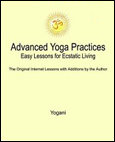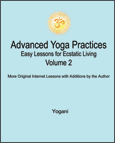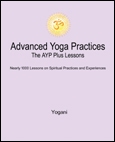|
Public Home | Plus Home | Main Lessons | Tantra Lessons | Public Forum | Plus Forum | Downloads | Books Topic Paths | Search | Training-Retreats | Testimonials | Survey | Interviews | MultiMedia | Contact | Donate |
|
Advanced Yoga Practices Note: For the Original Internet Lessons with additions, see the AYP Easy Lessons Books. For the Expanded and Interactive Internet Lessons, AYP Online Books, Audiobooks and more, see AYP Plus. Lesson 204 - Summary of Principles, Abilities, and Practices (Audio)
AYP Plus Additions:
From: Yogani New Visitors: It is recommended you read from the beginning of the web archive, as previous lessons are prerequisite to this one. The first lesson is, "Why This Discussion?"
That is the goal in these lessons -- to provide the essential means to stimulate the nervous system to purify and open itself, which it is very inclined to do when given the opportunity. Once the ball gets rolling, many aspects of our natural inclination toward human spiritual transformation will kick in. The goal here is to assist you in becoming self-sufficient in yoga like that. Way back in the beginning of the lessons, we talked about natural abilities contained within all of us that only need some stimulation to move us toward conscious inner openings to the infinite. These abilities are rooted in several fundamental principles that are inherent in our nervous system. We are all designed and built to experience unending divine ecstatic bliss! In this lesson we will review the fundamental principles, the natural abilities that stem from them, and the practices that have been given that stimulate these natural abilities. The essence of yoga science is discovering and applying the simplest and most powerful means for leveraging the natural abilities we have to hasten our spiritual transformation. That is what these lessons have been aiming to do. The fundamental principles of human spiritual transformation are simple enough, and we have touched on them often in the lessons, discussing from many different angles. There are five of them:
1. Attraction - To truth and/or God, expressed as desire - It is Love. 2. Purification and opening - A process every human nervous system is naturally inclined to go through. 3. Inner silence - Pure bliss consciousness, our native state that shines though our nervous system as purification and opening occur. 4. Ecstasy - Experienced when our nervous system is stimulated by the awakening our inner life-force. 5. Union - our transformation to a permanent state of compassionate unity, the fruition of the merging of our inner silence and ecstasy - It is Love.
1. The ability that desire, consistently applied toward an objective, has to move our inner and outer expressions of energy (life-force) in ways that fundamentally change our experience of life. 2. The ability our mind has to move naturally toward stillness. This is awareness without any objects - also called inner silence, or pure bliss consciousness. 3. The ability of the mind to effortlessly refine the thought of a sound, naturally bringing the mind to stillness over and over again. Certain sounds resonate with certain aspects of our nervous system. These sounds can be used selectively to stimulate the nervous system toward an orderly transformation. 4. The mind-body connection that enables naturally cultivated stillness of mind to induce stillness of our body, metabolism, and breath. This is the connectedness of yoga, experienced in many ways through our opening nervous system. 5. The ability of our nervous system to naturally sustain the quality of stillness, our silent blissful inner consciousness, even when it is not being cultivated. This is called a state of "silent witnessing," among other things. 6. The ability of restraint and regulation of breath to influence the flow of life-force in the nervous system, producing a sensation of relaxation and, ultimately, feelings of ecstasy in the body. 7. The ability of inner silence and the flow of life-force in the body to remove obstructions lodged deep in our nervous system, purifying and opening our awareness gradually to an expanding experience of inner peace, creative energy, happiness, and love. 8. The ability of restraint and regulation of breath to "awaken" the vast storehouse of life-force located in our pelvic region -- sexual energy that is drawn upward in our nervous system to compensate for a reduced intake of oxygen when the breath is gently restrained. 9. The ability of attention to influence the flow of the life-force in the body, especially when combined with restraint and regulation of breath. 10. The ability of certain nerves and nerve plexuses to be stimulated physically to enhance and direct the flow of life-force in the body.
12. The ability of the nerve in the center of the spine to conduct the life-force and ecstatic energy between the pelvic region and the third eye. This is called the spinal nerve. 13. The ability of the spinal nerve to radiate life-force and ecstatic energy throughout the entire body, enlivening every aspect of the higher neuro-biology within us in a smooth and orderly way. This is the rise of permanent ecstatic conductivity. 14. The ability of the nervous system to amplify the power of a thought when the thought is initiated deep in inner silence, yielding great purifying effects in the body and surrounding environment. 15. The ability of inner silence and ecstatic energy to merge and be sustained as one self-conscious presence in our nervous system. This is experienced as ecstatic bliss. This we come to know as the expression of our Self. 16. The ability of ecstatic bliss to flow out from us to our surroundings as divine love. Then we find our Self in the form of all we encounter. This is the natural flowering of divine love in service to all beings.
Everyone reacts a little differently to the processes of stimulation through yoga practices, due to the differences we each have in the structure of inner obstructions that are to be steadily and safely dissolved. We all can make the journey of transformation through yoga. It is only a matter of managing the conduct of our practices. This we call, "self-pacing." We have built up an integrated system of practices that stimulate the activation of the abilities listed above, bringing to our conscious experience the fulfillment of the five fundamental principles. Let's now list the practices for review.
1. Cultivation of desire for practices - bhakti (love of truth and/or God in the heart). Bhakti/desire is the engine that drives all yoga practices. We accomplish it by favoring a chosen high ideal (ishta) with all of our desires and emotions, whether they are positive or negative. In this way, a huge momentum driving us toward enlightenment is created within us and around us. Then everything we need to progress on our journey is drawn to us magnetically, including the willpower to engage in daily advanced yoga practices for as long as it takes to complete our journey. 2. Deep meditation with the mantra (plus three mantra enhancements along the way). Meditation involves bringing the mind (and body) to stillness over and over again twice daily, stimulating deep purification in our nervous system, and yielding permanent inner blissful silence. 3. Spinal breathing pranayama - the primary practice for awakening and balancing the life-force in the spinal nerve between the third eye and root. The life-force is also called kundalini. 4. Enhancements to spinal breathing, increasing stimulation of the life-force in the spinal nerve. 5. Mulabandha/asvini - awakening the life-force (kundalini) at the root. 6. Sambhavi - a means for producing direct physical stimulation of the neurological mechanisms of the third eye in the head. Controlled and stable stimulation of kundalini at the root and throughout the nervous system is achieved in this way. 7. Asanas (postures) - systematic bending and stretching of the body that is a natural complement to spinal breathing pranayama and deep meditation. Asanas help cultivate and purify the nervous system. 8. Siddhasana - a powerful way of sitting during practices for awakening kundalini at the root. Over time, the entire nervous system is illuminated by this procedure, performed effortlessly during all sitting advanced yoga practices. 9. Yoni mudra kumbhaka - a practice that helps open the third eye and awakens the life-force/kundalini in the entire nervous system through kumbhaka (breath retention) and associated mudras and bandhas. 10. Tantric sexual relations (the holdback method) - similar to the dynamics of siddhasana and used during sexual relations with or without a partner. Tantric sex is a powerful way to enliven and distribute the life-force (kundalini) throughout the body. 11. Kechari mudra (five stages) - Entering stage 2 kechari is one of the most dramatic transitions in all advanced yoga practices. It is a primary stimulator of kundalini, and a major cause of the rise of permanent ecstatic conductivity in the nervous system. 12. Uddiyana bandha and nauli - stimulating the upward movement of kundalini using the diaphragm and abdominal muscles. 13. Dynamic jalandhara (chin pump), with or without kumbhaka (breath retention), stimulating ecstatic energies between the heart and head, and throughout the body. 14. Samyama - the process of initiating and releasing particular thoughts (sutras) deep within our inner silence, producing powerful purifying effects throughout the nervous system. The effects can manifest as so-called supernormal powers, which are called siddhis. Samyama is done for spiritual purification and the rise of the unity experience. 15. Spinal bastrika - a breathing method that dramatically accelerates the purification of the spinal nerve, and the entire nervous system. 16. Targeted bastrika - a breathing method for focusing on and clearing out stubborn karmic obstructions lodged in particular areas of our spiritual anatomy. 17. Crown to root bastrika - another breathing method for purifying the sushumna between the crown flower cup and root. It is best undertaken only after extensive purification of the nervous system has been achieved through spinal breathing, deep meditation, and other methods that cleanse the nervous system of karmic obstructions in a smooth and progressive manner. Premature opening of the crown can lead to much difficulty, discomfort, and distraction on the path, so this advanced practice is best undertaken only when tests of stability have been successfully conducted at the crown. 18. Loving service to others - a conscious practice, and a natural result of the increasing outward flow of divine love resulting from the purification and opening of the nervous system produced by advanced yoga practices. This is our natural state of being - an endless overflowing of ecstatic bliss and divine love. Nothing on this earth, or beyond, is more real or more powerful than this great truth that is inherent in every one of us. The reality of divine love is the ultimate truth in us. As we become advanced in yoga, this becomes crystal clear. For some it is known right from the very first sitting in deep meditation.
With a twice-daily routine of practices, we place ourselves on a "fast track" to enlightenment. It is potentially so fast that it is essential that we develop skill in regulating the practices we are doing each day, measuring each practice by the clock. We adjust practice times as necessary to maintain smooth and steady progress without incurring excessive discomfort due to too many obstructions being released in our nervous system. This regulation of practices is called "self-pacing," and it too is a practice - one of the most important practices. For, without good self-pacing, we are not likely to get very far on the road to enlightenment. Another aspect of advanced yoga practices is the prudent handing of experiences, whether they are mundane or extreme. This is a path of enjoyment, and we are entitled to enjoy the "scenery" we encounter on our journey to enlightenment. However, the scenery is not what will advance us on our path, It is our practices that will move us ahead. So, after an admiring look at the passing scenery, no matter how beautiful or attention-grabbing it may be, we easily go back to the practice we are doing. If spiritual experiences come while we are in our daily activities, as they certainly shall, we then can continue to enjoy the experiences, or go back to whatever it is we are doing. We always have a choice. Spiritual life is not something that must be hijacking us from ordinary life. If it is, we have probably engaged in some kind of excess in the past, and a stable routine of practices can correct this. Spiritual life is something that can be cultivated to fulfill our daily activities in everyday life, whatever they may be. We are free to live our rising spiritual experiences in a way that is compatible with our needs. It is our life, our journey, and our enlightenment. We have no one to become but our Self. Enjoy! The guru is in you. Note: For detailed instructions on building a balanced daily practice routine with self-pacing, see the Eight Limbs of Yoga Book, and AYP Plus.
|
|
|
|
Join the Mail List:
AYP Retreats
eBooks - PDF, EPUB
FREE eBooks with
SAVE with Bundled
|

























